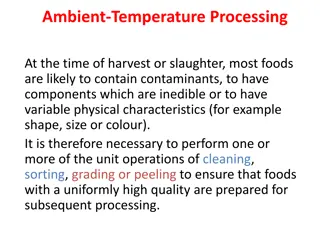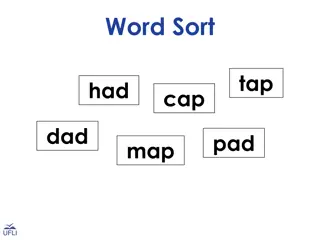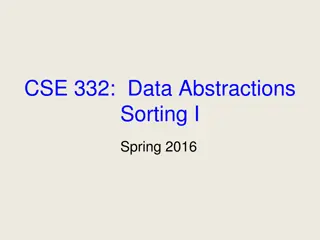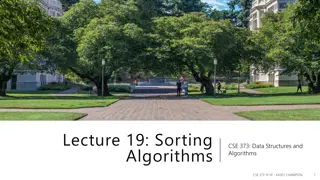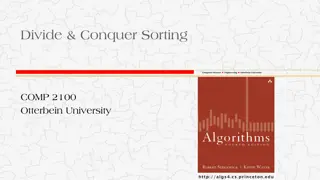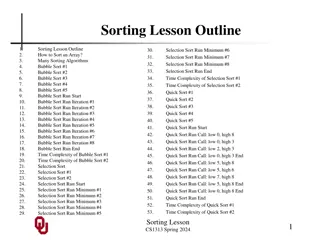
Binary Search and Sorting Algorithms Explained
Learn about binary search and sorting algorithms in computer science. Binary search is a method for finding elements in a sorted list efficiently, while sorting algorithms rearrange values in a specific order. Explore the concepts and code examples to understand how these techniques work.
Download Presentation

Please find below an Image/Link to download the presentation.
The content on the website is provided AS IS for your information and personal use only. It may not be sold, licensed, or shared on other websites without obtaining consent from the author. If you encounter any issues during the download, it is possible that the publisher has removed the file from their server.
You are allowed to download the files provided on this website for personal or commercial use, subject to the condition that they are used lawfully. All files are the property of their respective owners.
The content on the website is provided AS IS for your information and personal use only. It may not be sold, licensed, or shared on other websites without obtaining consent from the author.
E N D
Presentation Transcript
CSc 110, Autumn 2017 Lecture 37: searching and sorting Adapted from slides by Marty Stepp and Stuart Reges
Using binary_search # index 0 1 2 3 4 5 6 7 8 9 10 11 12 13 14 15 a = [-4, 2, 7, 9, 15, 19, 25, 28, 30, 36, 42, 50, 56, 68, 85, 92] index1 = binary_search(a, 42) index2 = binary_search(a, 21) index3 = binary_search(a, 17, 0, 16) index2 = binary_search(a, 42, 0, 10) binary_search returns the index of the number or - (index where the value should be inserted + 1)
binary_search Write the following two functions: # searches an entire sorted list for a given value # returns the index the value should be inserted at to maintain sorted order # Precondition: list is sorted binary_search(list, value) # searches given portion of a sorted list for a given value # examines min_index (inclusive) through max_index (exclusive) # returns the index of the value or -(index it should be inserted at + 1) # Precondition: list is sorted binary_search(list, value, min_index, max_index)
Binary search code # Returns the index of an occurrence of target in a, # or a negative number if the target is not found. # Precondition: elements of a are in sorted order def binary_search(a, target, start, stop): min = start max = stop - 1 while min <= max: mid = (min + max) // 2 if a[mid] < target: min = mid + 1 elif a[mid] > target: max = mid - 1 else: return mid # target found return -(min + 1) # target not found
Sorting sorting: Rearranging the values in a list into a specific order (usually into their "natural ordering"). one of the fundamental problems in computer science can be solved in many ways: there are many sorting algorithms some are faster/slower than others some use more/less memory than others some work better with specific kinds of data some can utilize multiple computers / processors, ... comparison-based sorting : determining order by comparing pairs of elements: <, >,
Bogo sort bogo sort: Orders a list of values by repetitively shuffling them and checking if they are sorted. name comes from the word "bogus" The algorithm: Scan the list, seeing if it is sorted. If so, stop. Else, shuffle the values in the list and repeat. This sorting algorithm (obviously) has terrible performance!
Bogo sort code # Places the elements of a into sorted order. def bogo_sort(a): while (not is_sorted(a)): shuffle(a) # Swaps a[i] with a[j]. def swap(a, i, j): if (i != j): temp = a[i] a[i] = a[j] a[j] = temp # Returns true if a's elements #are in sorted order. def is_sorted(a): for i in range(0, len(a) - 1): if (a[i] > a[i + 1]): return False return True # Shuffles a list by randomly swapping each # element with an element ahead of it in the list. def shuffle(a): for i in range(0, len(a) - 1): # pick a random index in [i+1, a.length-1] range = len(a) - 1 - (i + 1) + 1 j = (random() * range + (i + 1)) swap(a, i, j)
Selection sort selection sort: Orders a list of values by repeatedly putting the smallest or largest unplaced value into its final position. The algorithm: Look through the list to find the smallest value. Swap it so that it is at index 0. Look through the list to find the second-smallest value. Swap it so that it is at index 1. ... Repeat until all values are in their proper places.
Selection sort example Initial list: index value 22 18 12 -4 0 1 2 3 4 27 30 36 50 5 6 7 8 7 9 68 91 56 10 11 12 13 14 15 16 2 85 42 98 25 After 1st, 2nd, and 3rd passes: index value -4 18 12 22 27 30 36 50 0 1 2 3 4 5 6 7 8 7 9 68 91 56 10 11 12 13 14 15 16 2 85 42 98 25 index value -4 0 1 2 2 12 22 27 30 36 50 3 4 5 6 7 8 7 9 68 91 56 18 85 42 98 25 10 11 12 13 14 15 16 index value -4 0 1 2 2 7 3 4 5 6 7 8 9 10 11 12 13 14 15 16 22 27 30 36 50 12 68 91 56 18 85 42 98 25
Selection sort code # Rearranges the elements of a into sorted order using # the selection sort algorithm. def selection_sort(a): for i in range(0, len(a) - 1): # find index of smallest remaining value min = i for j in range(i + 1, len(a)): if (a[j] < a[min]): min = j # swap smallest value its proper place, a[i] swap(a, i, min)
Selection sort runtime (Fig. 13.6) How many comparisons does selection sort have to do?
Similar algorithms index 0 value 22 18 12 -4 1 2 3 4 27 30 36 50 5 6 7 8 7 9 68 91 56 10 11 12 13 14 15 16 2 85 42 98 25 bubble sort: Make repeated passes, swapping adjacent values slower than selection sort (has to do more swaps) index value 18 12 -4 0 1 2 3 4 5 6 7 7 10 11 12 13 14 15 16 50 68 56 2 85 42 91 25 98 8 9 22 27 30 36 22 50 91 98 insertion sort: Shift each element into a sorted sub-list faster than selection sort (examines fewer values) index value -4 12 18 22 27 30 36 50 sorted sub-list (indexes 0-7) 0 1 2 3 4 5 6 7 8 7 9 68 91 56 10 11 12 13 14 15 16 2 85 42 98 25 7



